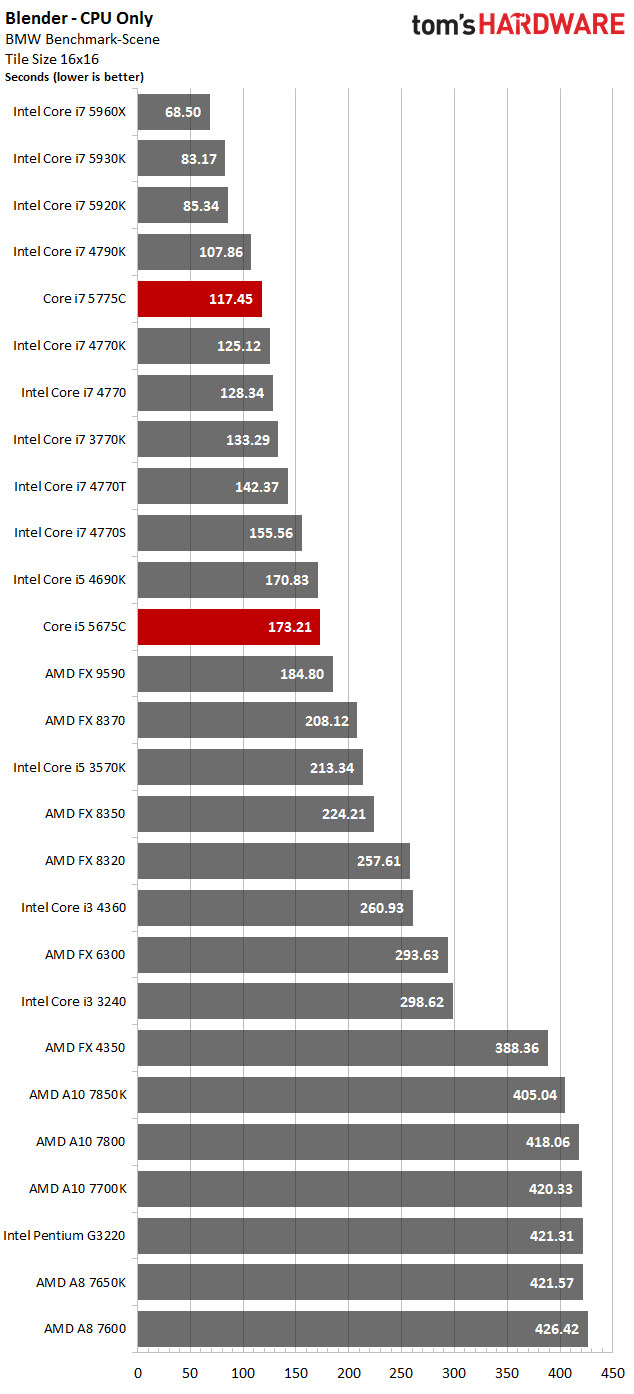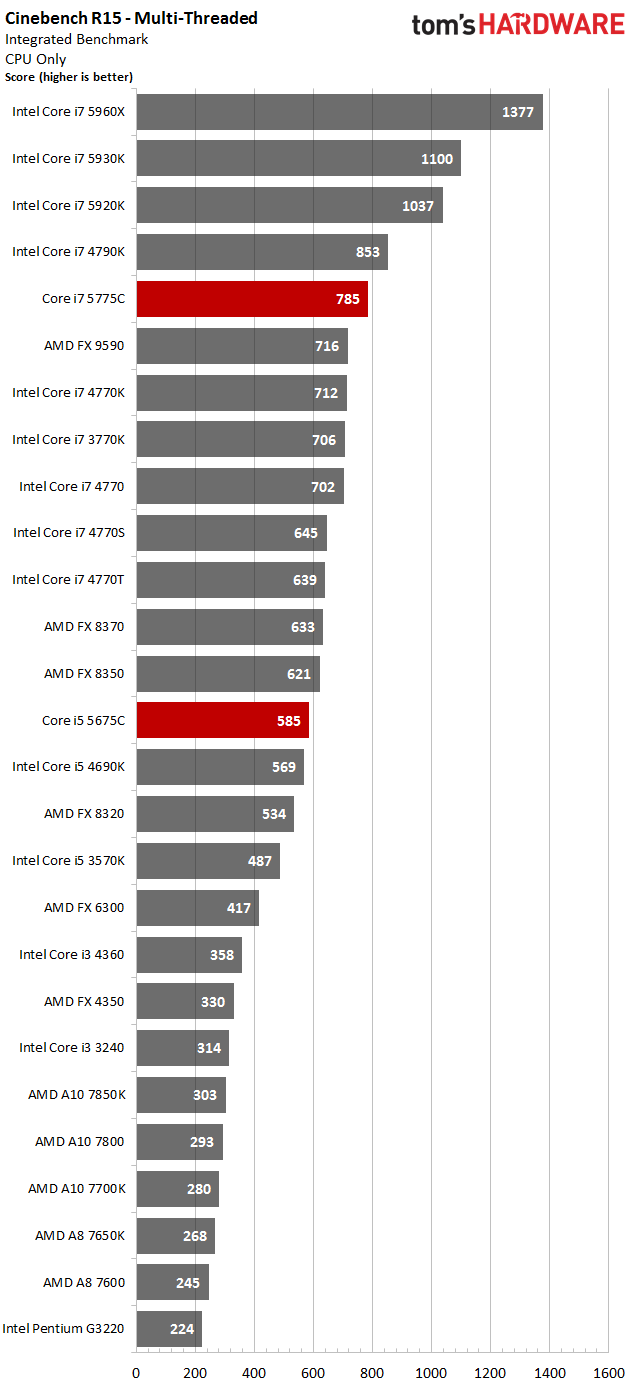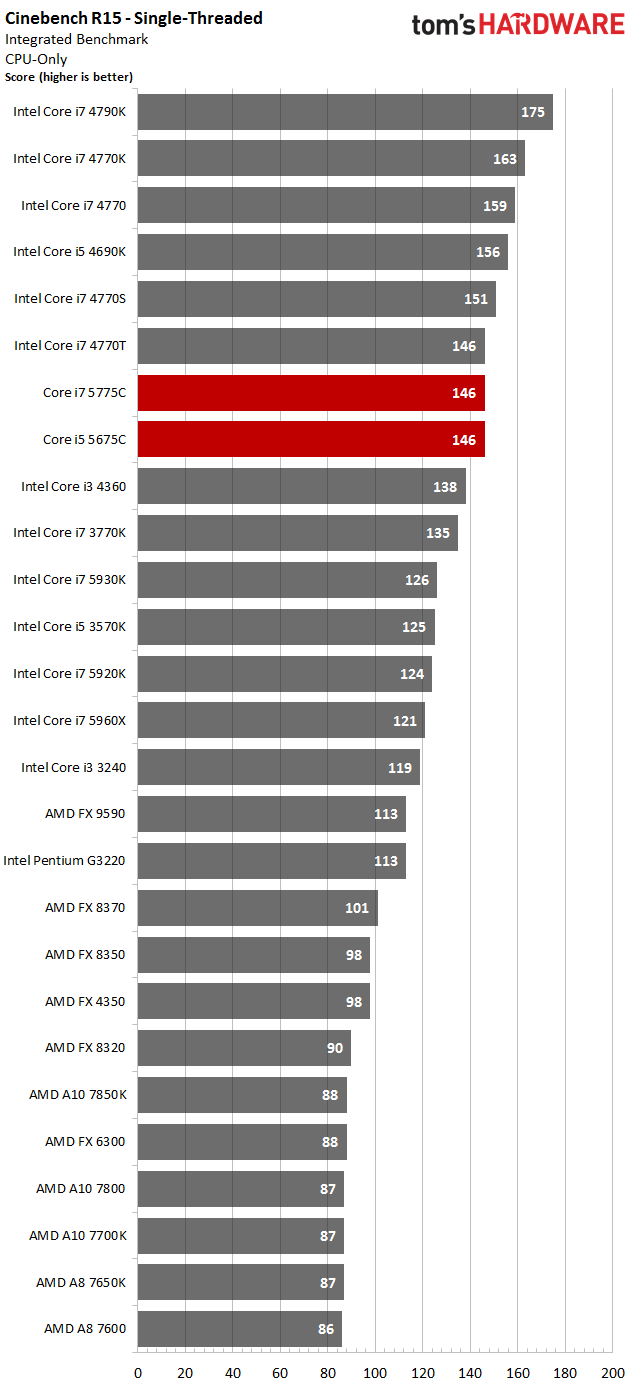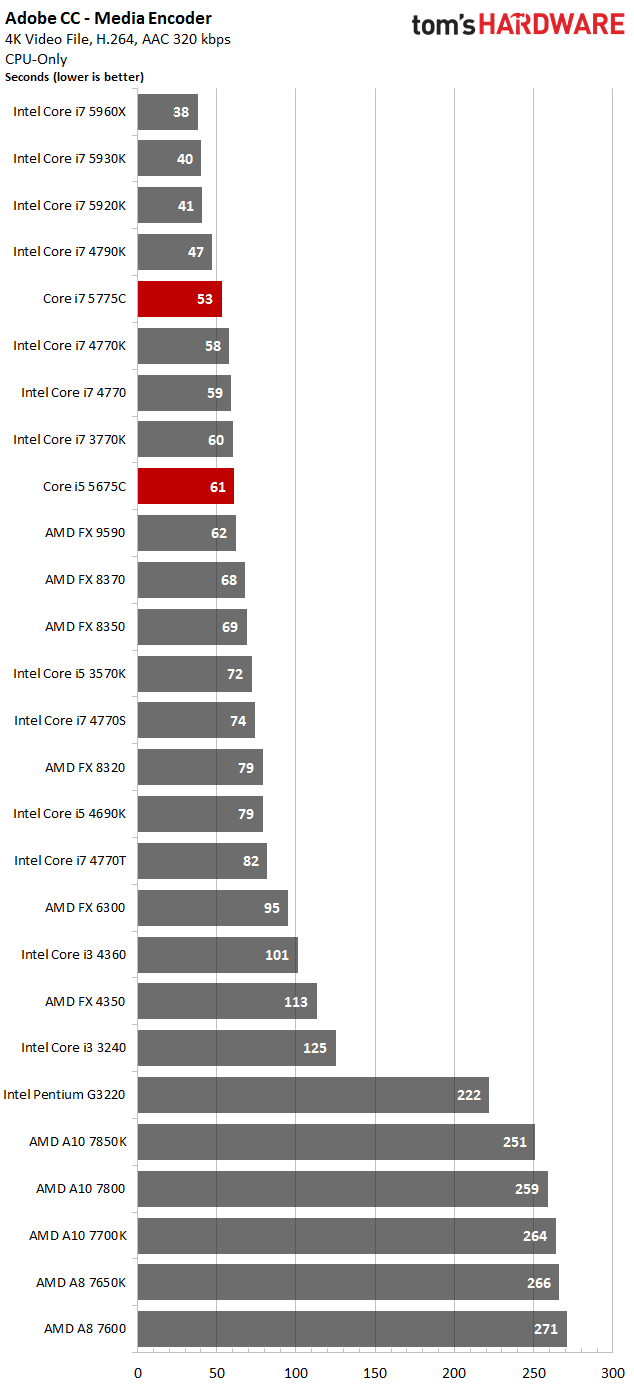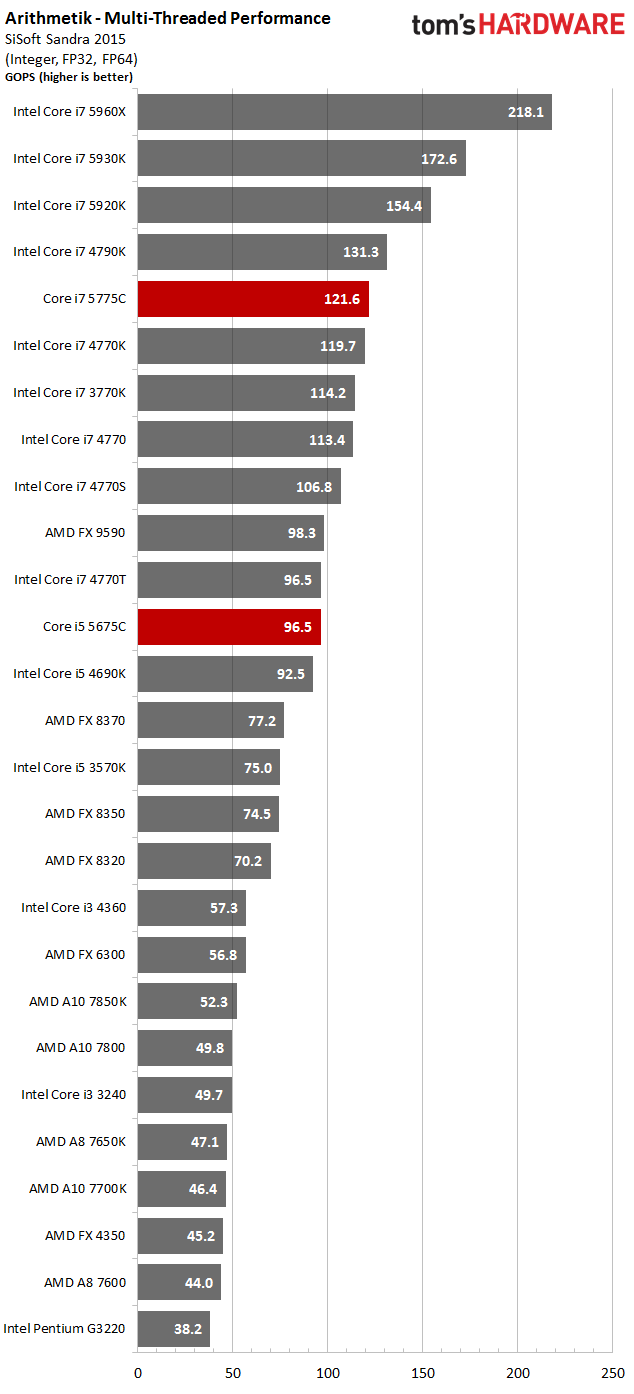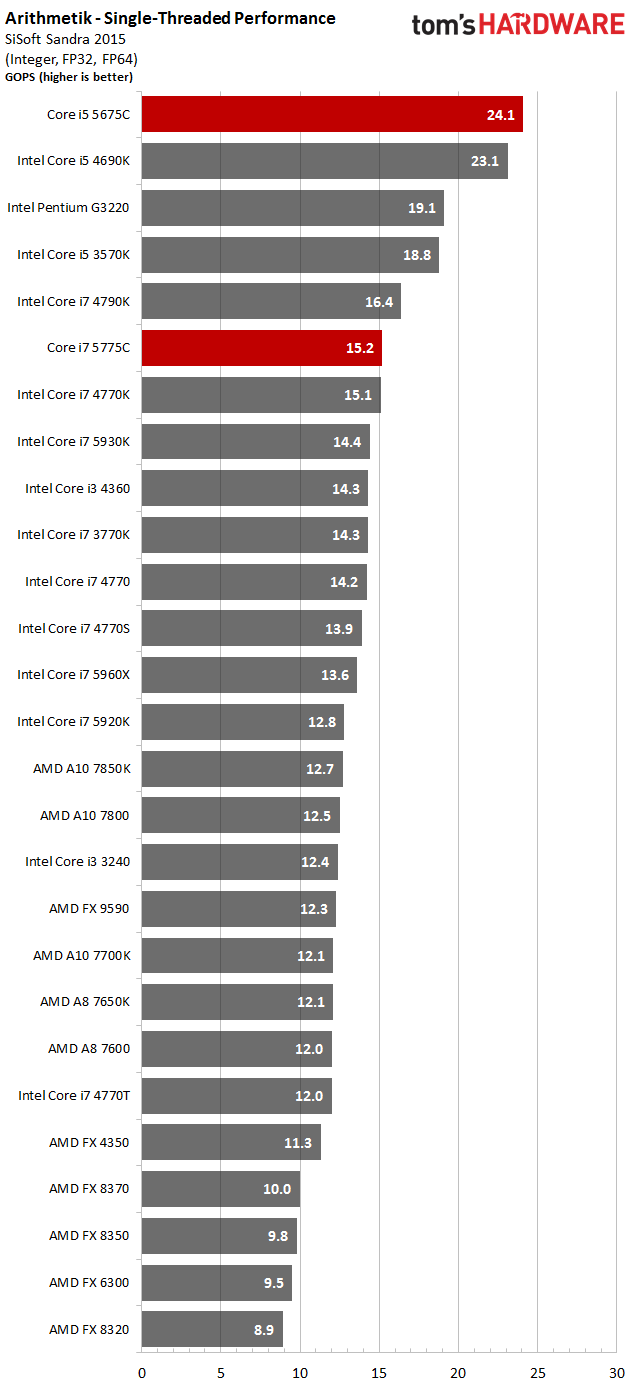Broadwell: Intel Core i7-5775C And i5-5675C Review
Rendering, Encoding, Compression, Arithmetic
Blender
Blender has an efficient rendering module that runs exclusively on the CPU, even though rendering our benchmark file using GPU acceleration is much faster. A tile size of 16 pixels has proven to be the most efficient for CPUs, so we’re using it for our testing. Both Broadwell-based processors fall in line as expected.
Cinebench R15
This benchmark, which is based on Maxon’s Cinema 4D, provides the interesting option to have the CPU render in single- or multi-threaded mode. The ratio between the two says a lot about efficiency, illustrating the difference between physical cores, modules and simultaneous mult-threading implementations.
That relationship between single- and multi-threaded performance is of particular interest. The former is the same across both new processors, and comparable to Haswell. Multi-threaded performance, however, is better. This leads us to conclude that Broadwell's multi-core efficiency is improved compared to Haswell, as long as the BIOS and microcode play their parts.
Adobe Media Encoder CC
We’re using a UHD video file with an audio track that we’ve recorded ourselves. It’s saved as an H.264 file with 3840x2160 resolution, 25 FPS, progressive VBR, one pass, and a 320 Kb/s and 48kHz AAC stereo soundtrack. We’re using the integrated software renderer, which makes optimal use of all possible threads. The results aren’t surprising.
WinZip 19 Pro – Compression
The trick with this benchmark is to compress different types of content, such as text, pictures, multimedia files, videos and applications, without producing troublesome overhead due to time-sensitive file operations. This is why we copy all 3.02GB worth of data to an ISO file that can be compressed in one go. We’re using the CPU, not the GPU acceleration via OpenCL.
SiSoftware Sandra 2015 – Arithmetic
If the overall results for the single- and multi-threaded benchmark runs are compared, putting heavy emphasis on integer and 32/64-bit floating-point performance, then the Core i7-5775C is found right between Intel's Core i7-4790K and Core i7-4770K, in spite of the new processor’s lower core frequency.
The Core i5-5675C manages to inch out the much higher-clocked Core i5-4690K. This advantage only emerges if an application performs a lot of 64-bit floating-point operations, though. Otherwise, Broadwell isn't quite as fast. It looks like synthetic metrics, at least, can extract more FP64 performance from Broadwell, though integer and FP32 throughput doesn't really improve.
Get Tom's Hardware's best news and in-depth reviews, straight to your inbox.
If you're only looking at single-threaded performance, the SMT-equipped processors do significantly worse. This helps explain why Intel’s Core i5-5675C does better in some applications than its bigger brother, the Core i7-5775C.
Current page: Rendering, Encoding, Compression, Arithmetic
Prev Page Office Productivity Next Page Workstation Applications-
RNOblivion Proof read your articles. This seems to be an increasing prevalent theme of Tom's over the last couple years.Reply -
greghome are these numbers real?.............Not only does it match lower mid range cards, but it completely destorys AMD's APUs........Reply
:shock: -
Nuckles_56 With the Sandra 2015 benchmark on the first page, you are testing the i7 7557c against the i7 4790k instead of the i7 5775cReply -
babernet_1 Sad how AMD is absolutely shoved into the dust bin. I hope their upcoming Zen next year will be worthwhile with its 14nm process and more Intel-like cores.Reply
-
wtfxxxgp This is exactly what I said to a buddy of mine about a month ago. Everyone is going on about how little Intel has done with CPUs over the past few years - presumably due to no real competition from AMD. Then people starting looking to Zen as being the real competitor for Intel and saying things like "Intel are in for a shock" - I had the view that Intel weren't resting on their laurels all this time - they've just been biding their time and doing amazing things in a hush hush manner. When Zen is released it will soon be completely obliterated by some of the tech that Intel would have been working on in the meantime - AMD has lagged too far behind for too long and love them or hate them, Intel is the benchmark when it comes to CPUs - period. They own this space, and these 2 chips have just rendered AMD APUs completely useless now. I'd be interested in this for a HTPC solution with some light gaming - League of Legends etc. This is impressive, however, like the article concluded, what a poor time for them to be released.Reply -
Grognak Wow. 93% better average framerate in GTA V than a 7850K with DDR3-2400 RAM... And that's just the i5. Incredible.Reply -
shrapnel_indie Since Broadwell is unlocked, would have been interesting to see how they overclocked. Yeah Skylake is breathing down the neck of Broadwell now thanks to the delays it suffered... but still would be fun to see.Reply
You’ve waited this long—why not hang tight for a few months for Skylake and start anew with 100-series chipsets, DDR4 and the return of unlocked 95W K-series CPUs?
Last I heard Skylake was supposed to support DDR3 and DDR4. Was that just a rumor that wasn't the truth or will it actually support DDR3 as well?
-
alpha27 heh iris coming close to a 750gtx 500 cuda core NVidia better watch out heyReply
hmm if intel whacked a few iris's on a gfx chip and did there thing they could possibly beat NVidia...and make even more money lol, hmm mutli 128mb ring buses and iris core's and hbm...delicious -
de5_Roy it's a good review. two big reviews back to back, nice job. :)Reply
i missed some things:
unlocked broadwells but no o.c. not even a little look into how these overclock and behave o.c.ed.
no comparison (gaming, power use, htpc etc.) with the desktop haswell i5 and i7 -R cpus' iris pro igpus. the amd comparisons were good though. i hope you guys test these against the haswell iris pro later.
in some of the charts, the core i7 5775 was written as i7 7557.
in the test setup page, system memory section, is it "transcend" instead of "transcent"?
edit:
one last thing: do these unlocked broadwell cpus really have 16x gen 3.0 lanes off the processor? i thought these were soc dies (with southbridge disabled) with 8x gen 3.0 lanes. -
SteelCity1981 not surprising given that it has an irs pro gpu in it, that's intel top of the line gpu. now obv even with that said it's in no competition with highend gpus from NVidia or amd as any apu's gpu would get destroyed, but what's good is the fact that it's helping to push gpus on apu's to become better and better and since intel has greatly stepped up their game in the apu's gpu department i'd expect amd to step up their game even further and push back. I also see that since there is such a big gain with broadwells gpu, that skylake won't see any real jump in that department. i'd imagine that the irs 6000 series is going to carry over onto skylake with little improvement over broadwells irs 6200.Reply
